Foreign Insulators
by Marilyn Albers
Reprinted from "Crown Jewels of the Wire", June 1999, page 10
ANOTHER UNIQUE IRON CLAD INSULATOR
FOUND IN URUGUAY
Quite some time ago, I received a letter from Crown Jewels of the Wire
subscriber Gustavo (Gus) ColI of Montevideo, Uruguay, who had come across the
shell of an interesting old iron clad insulator. Engraved on the side of the
crown in capital letters was the name of the company known as JOHNSON &
PHILLIPS ENGINEERS, LONDON.
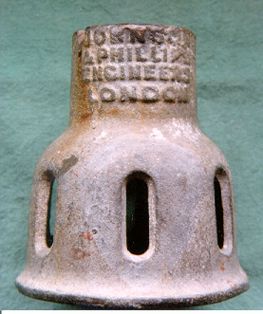
Front view of the insulator made by
Johnson & Phillips Engineers, London.
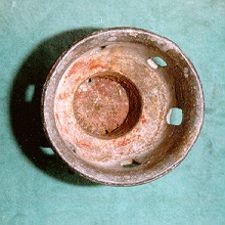 |
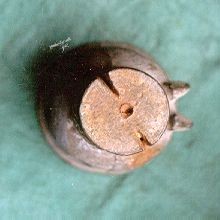 |
|
"A peak up inside the shell. " |
"Looking down from above. " |
Here is what Gus wrote:
"I think that the subject of this rather odd type of insulator could be
of some interest to you. In a flea market recently, I found the remnants of a
Johnson & Phillips Engineers iron clad insulator. What makes my find so
interesting is that this manufacturer is mentioned in Mr. W Keith Neal's books
only as a supplier of oil insulators, some of them metal capped, but not quite
iron clad. It would appear that perhaps a new name can be added to the list of
companies who produced plain iron clad insulators.
On the other hand, it could
be that this piece is really what is left of a Johnson & Phillips oil
insulator. Please see page 61, Figure 78, item 10, of "Searching for
Railway Telegraph Insulators ". This was very interesting to me, as I never
expected this type of insulator to be found here.
The other minor detail I
noticed is that throughout his books Mr. Neal only mentions "Johnson &
Phillips ", skipping the word "Engineers ", but maybe I am making
a mountain out of a mole hill.
I enclose some pictures, in the hope that perhaps
you can throw some light on the subject. The grooves that you see on the top are
the unfortunate result of somebody trying to make a bell out of it, and very
clumsily at that. The insulator is 4-1/4" in height, the diameter of the
skirt is 3-7/8 ", and the diameter of the crown is 1-1/8 ".
After looking at the first two photos it's quite obvious that the porcelain
insert has been broken out, but if you peer closely up inside the top of the
iron shell, you can see some circular ribs or threads in the metal, which were
designed to hold the insert in place with cement. The windows in the iron shell were put there for a reason - to let the rain wash the dirt and
spider webs away from the porcelain. The purpose of the two cast iron hooks
attached to the outer shell, as shown in the second photo above, were put there
to hold the line wire should it become slack, and to prevent it from falling
away from the insulator.
We now know of three slightly different styles of heavy
iron clad insulators with these little windows - the FULLER BOW example with one
hook, which was used on lines in England, the P. WALTERS & CO. LONDON type
with two hooks, manufactured in England for export to Uruguay, and now this
unique style marked JOHNSON & PHILLIPS ENGINEERS LONDON, that was found in
Uruguay.
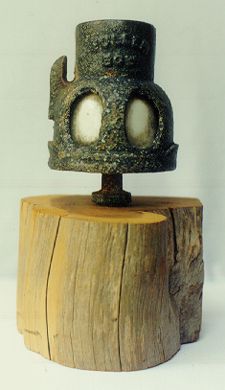
"FULLER BOW"
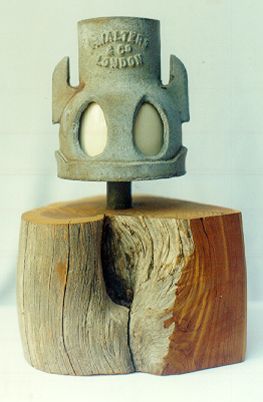
"P. WALTERS & CO. LONDON"
Earlier Iron clad insulators did not have these windows and as Keith Neal
wrote in his second book RAILWAY AND OTHER RARE INSULATORS - "In use they
had several disadvantages, the first being that they attracted spiders who spun
webs in the darkened part inside, which attracted damp and caused at least
partial failure of insulation. They also allowed smoke deposit to build up
without the benefit of the rain to wash it clean. The iron cover being made so
close a fit to the porcelain it protected, the carbon deposit thus caused
further failure being a conductor. The first iron clad with hooks and no windows
was the worst offender (see photo on following page) and it was rapidly
supplanted by the FULLER BOW example. This one had a long life, being particularly useful where
persistent stone throwing was a problem".
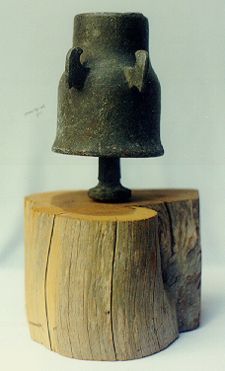
"The worst offender had no windows".
A 1910 catalog published by SIEMENS BROTHERS & Co. Ltd. in London
indicates that this company did indeed produce iron clad porcelain insulators
for use on telegraph lines in England, as well as in other countries. Gus, many
thanks for sharing your interesting new find with Crown Jewels of the Wire
readers.
A NEWLY DISCOVERED MARKING ON A BRITISH U-1257
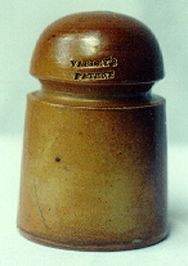
"VARLEY'S PATENT"
The U-1257 was a successful and well known porcelain insulator made in
England for use on British telegraph lines, with a few exported to other
countries. Some were glazed white, but most of them had what is known as a brown
salt glaze, which was not only attractive but did a good job of protecting the
insulator from the elements.
At a recent Lone Star Insulator Club meeting at the
home of Jim Fielding in San Antonio, Texas, I was able to buy a U-1257 from Ross
Baird, who was set up for business in Jim's garage. I was thrilled to see
VARLEY' S PATENT incused on the crown because I'd never seen that particular
marking variation on a U-1257. The cemented inner skirt had been removed from
the shell but the body of the insulator was in good shape and it did indeed have
a lovely brown salt glaze, which put a big smile on my face for the rest of the
afternoon.
The known markings that appear on U-1257's are (1) WARDEN & CO.
WESTMINSTER, (2) A (over) I.E. SAUNDERS & CO., (3) ROBERT JOBSON (over)
DUDLEY, (4) HOWARD C. JOBSON (over) DUDLEY, and (5) just the letter Z by itself
which identifies the insulator as a Varley's Patent. With the exception of the
newly found marking VARLEY'S PATENT, all of the above variations are shown in W.
Keith Neal's first book Searching For Railway Telegraph Insulators.
EMBOSSING ERRORS ARE HIGHLY COLLECTIBLE
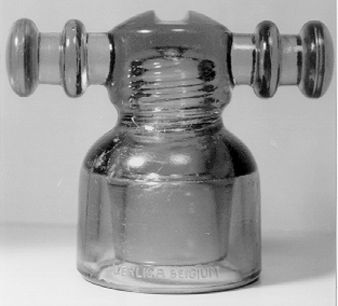
CD 682 embossed VERLICA BElGIUM not
VERLICA BELGIUM
Paul Greaves of Rosedale, California came across this pretty light green
T-bar (CD 682) and noticed that one word in the embossing was spelled
incorrectly. If you missed it, look again! It should be BELGIUM rather than
BElGIUM. I know he must treasure this insulator even more than if it had been
perfect. However, I'm sure the glass maker's boss was not happy to learn that
every insulator coming out of that particular mold would be repeating BElGIUM,
BElGIUM, BElGIUM, BElGIUM.. . . . .!
There must be something attractive about
these mistakes because I like them, too. It's fun to have an insulator with an
embossing error, especially if there's a perfect example sitting next to it on
the shelf. :-)))
Paul described the embossing error by e-mail and his wife Kathy
took several photos of the insulator, which she sent to me. Since all the shots
were good, it was hard to choose the best one for this article. Paul and Kathy,
your efforts are much appreciated.
TWO PILKINGTON COUSINS
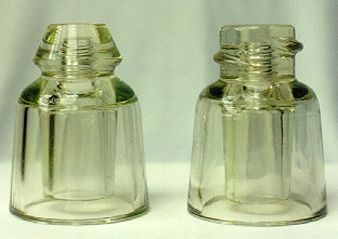
"CD's 435 and 436"
These two unembossed glass insulators in light straw were both designed for a
threaded pin. They are products of the British company formerly known as
Pilkington Brothers Ltd. of St. Helens, Lancashire, England, which was first
established in 1845. CD 435 on the left in the photo is one of a group of
insulators that were used on the L.M.S. line (London, Midland, and
Scottish
Railway) as a replacement for the U-1452, which was the standard Cordeaux
Pattern line insulator, but this style in glass did not prove successful.
W. Keith Neal, author of the book Searching For Railway Telegraph
Insulators,
wrote:
"I was told they (CD 435 's) were tried out on one section of the line
but never adopted, the condensation of the damp climate rendering them
unsatisfactory. Their only advantage was that no spiders would go near them as
they did not like the light and never spun their webs inside."
With the help of a friendly lineman, Keith was able to retrieve two examples
of CD 435 before they all came down. He kept one of them, which you can see in
figure 63, page 53 of his first book. He donated the other insulator to a museum
in England, but unfortunately it was never put out for display. That second
insulator eventually ended up in the hands of a Canadian collector, but that's
an entirely different story.
Notice that CD 436, shown to the right in the
photo, has one molded glass thread circling the crown. This particular example
was one of two that were taken down from a telegraph line in South America. Keep
in mine that the Pilkington factory exported glass insulators to many parts of
the world. I keep staring at this 436 and wondering if a threaded metal cap was
meant to screw onto the crown of the insulator to hold the tie wire in place. Or
did the glass thread make it possible to unscrew the insulator from its peg
without having to untie the wire? Was this particular style successful as a pole
line insulator? When were they first installed on telegraph lines in South
America and how many were sent over from England? Are any of them left on the
lines? Perhaps one day we will know the answers.
| 